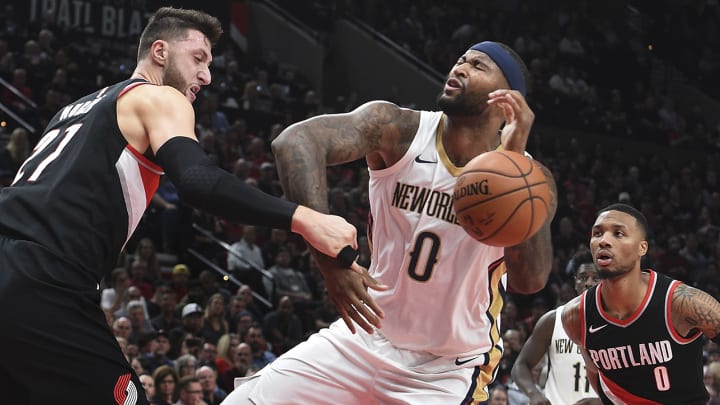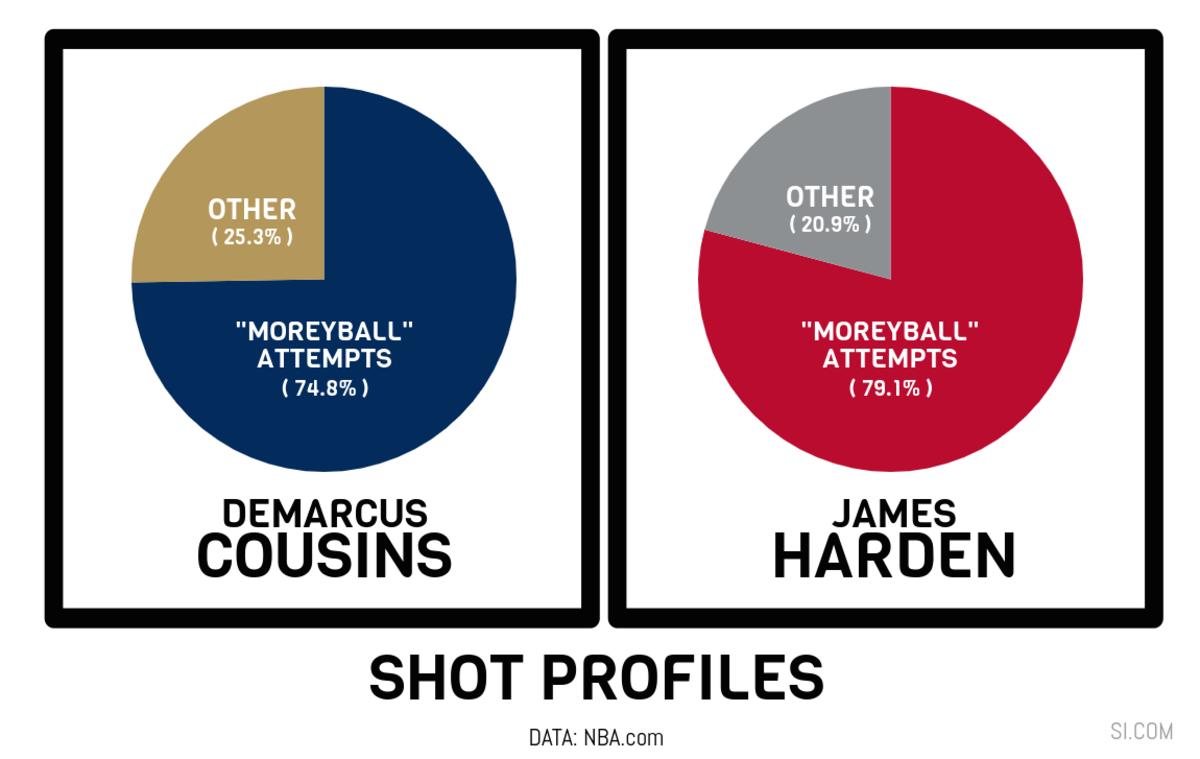DeMarcus Cousins: The James Harden of Centers

DeMarcus Cousins returned to the Pelicans this season with a leaner frame and even leaner shot profile. For years, he had been held back by indulgence in long, two-point jumpers that accomplished little, save for protect defenders from his punishing interior game. The solution—one that has led to career-best efficiency—was not to box Cousins in, but to empower him to go even further out.
The three-point line has become a fascinating threshold. Put a capable shooter behind it and the entire dynamic of a possession changes. Defenses are forced to stretch in exaggerated ways to deny attempts from beyond the arc, creating openings elsewhere. The sheer number of three-point shooters that most teams put on the floor completely warps the geometry of defensive systems. Everything changed once the league hit a critical mass of three-point acceptance. The simple reality is that most of the best defenses in NBA history would be worthless against today’s long-range offenses. Principles geared toward hand-to-hand combat just aren’t of much use once ballistics are involved.
Cousins has become an unlikely emblem of the movement. Somehow, the league’s most terrifying post scorer is also the artillery behind 7.6 three-point attempts per game. That average makes Cousins the seventh-most prolific three-point shooter in the league, but his figure would have led the NBA outright in the majority of seasons since the three-point line’s introduction. That he makes just 34.6% of his threes is almost beside the point; Cousins’s size demands a big, traditional center as his defender, and yet the changing shape of his game serves to exploit just that kind of opponent. That Anthony Davis requires a quicker, more agile defender cements the matchup nightmare.
Any lingering concerns about how Cousins and Davis might coexist have been decimated by their joint success. Both are so flexible as to oscillate comfortably between playing inside and out, adapting to whatever best suits their circumstances. They are far from twin towers. The entire offense revolves around the wide variety of ways that both Cousins and Davis can be deployed, and thus far New Orleans has been tremendously successful with both on the floor.
The NBA's Best Unicorn: Kristaps Porzingis
When Cousins isn’t backing his man down, he’s peering over him from the top of the floor. Most often, the three itself is little more than an implied threat. It beckons a defender closer, pulling a rim protector out of his natural jurisdiction and clearing the way for the Pelicans’ cutters. This is where we see many of Cousins’s 5.8 (!!) assists per game materialize; only about 10 players in the league assist more field goals at the rim. It’s traditional high-post action pushed further out and to its logical conclusion.
By putting Cousins to work in this space, the Pelicans haven’t just turned him loose as a three–point shooter. They’ve empowered him as a driver. This mammoth human being can rumble down the lane on command, striding right past his slow-footed counterpart in the process. Bigs in the league today might be practiced in containing guards on the perimeter out of pick-and-roll situations, but in this scenario they have no way of using their size and length to their advantage. Cousins is huge, he’s physical, and he’s exceptionally clever. His handle is smoother than it has any right to be. He’s also faster than most any other player at his position, leaving centers at the mercy of moves like this:
How the hell is anyone supposed to contend with that? Even if a defense collapses down on his drives from the corners, Cousins will beat you on simple plays:
Cousins—one of the biggest centers left working—has become a downhill player. He drives more times a game, according to NBA.com, than Kyrie Irving, Stephen Curry, Kevin Durant, Jimmy Butler, Paul George, and C.J. McCollum. As a ball-handler, he has initiated three times as many pick-and-rolls as Al Horford and over 10 times more than any other center, per Synergy Sports. Even those who stick with him on the way to the rim are so easily moved out of the way. All it takes is a slight hesitation to pull the defender off balance and a bump of the shoulder to keep them there. Cousins has been creating separation to get up shots his entire basketball life. Now he’s doing it on a beeline toward the rim with the entire defense powerless to stop him.
Having both the three and the drive on the table at all times has brought Cousins alarmingly close to statistical ideals. He is the James Harden of centers—a wrecking ball of threes, free throws, and shots right at the rim, with little allowance for the fat in between. Consider the similarity in what percentage of each player’s shots come from the highest-value spaces on the floor:

“Moreyball attempts” are defined as shot attempts from the restricted area or three-point range.
Harden, a paragon of efficiency, nearly mirrors Cousins in effective field goal percentage. Both are among the most–fouled players in the league and also the most turnover-prone; monster usage rates paired with high driving frequency comes with the inevitable risk of empty possessions. Both more than make up for it by maximizing the rest. There is a commonality in the way each changes speeds. Cousins and Harden beat their opponents off the dribble through quick bursts and body control, the combination of which keeps defenders at a remove. It’s no wonder opponents are tempted to swipe desperately at the ball—connecting often with the arm—in the process. The effectiveness of both stars has as much to do with downshifting as it does explosion. It’s athleticism subtly manifest, understated and impossible to predict.
There are obvious differences between the two, starting most superficially with the fact that Cousins is a big-time rebounder and Harden an exceptional playmaker. No one would confuse one player for the other. What’s material is that both still produce in the same terms. That Cousins dances less with the ball or that Harden plays at a different pace doesn’t change the congruency in their shot charts. Both are working toward similar ends, which is in itself an incredible tribute to Cousins’ progression. It wasn’t long ago that shot selection was a genuine issue for Cousins, whose settling had undercut his potency. No more. Ill-advised shots still creep up from time to time, but even those looks have been redistributed toward far better returns. This is Cousins having his cake and eating it, too—an insatiable scorer taking the next step by changing the way he sets the table.
